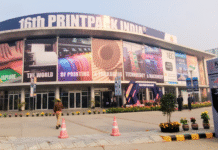“Translation is important because it allows you to go beyond language, it allows you to explore different worlds, philosophies, customs, and traditions,” observed Sanjoy K Roy, managing director of Teamwork Arts. Roy was welcoming the audience of readers, writers, and publishers at the celebratory evening organized by the producer of the Jaipur Literature Festival, to commemorate author Geetanjali Shree’s historic win at this year’s International Booker.

At the book reading and discussion on 5 July 2022 at the Stein Auditorium at New Delhi’s India Habitat Center renowned journalist Poonam Saxena engaged Shree on the characters, themes, and eccentricities of her book Ret Samadhi published by Rajkamal Prakashan in Hindi. The English translation – Tomb of Sand, published by Titled Axis in the UK and Penguin in India, has just won the prestigious award for translations, bringing Hindi and the entire bucket of South Asian languages into the limelight.
Shree said she hopes Tomb of Sand achieves the recognition that South Asian literature deserves – perhaps creating an opening to the many interesting authors that are writing in its numerous languages and now increasingly finding translation. She then went on to read out a witty and humorous extract from Ret Samadhi allowing the audience to admire and acknowledge the depth and dexterity of her language and work.
Language is an entity by itself
In the conversation with Saxena, Shree explained that she dabbled in theater before taking up writing as a full-time profession and continues to delve into this experience to present her thoughts in her unconventional style. “Language is an entity by itself. It is not something that has to be used as a vehicle to say something. It is the power of language that takes over and makes me write in a certain way,” she said. Playing with words she said helps her unlock new meanings and to think from independent and emerging perspectives.

Ret Samadhi plays with a variety of themes including family dynamics, the partition, mental health, the loss of a loved one, and old age and its associated health issues. The author added that the theme is also about the partitions that emerge in one’s life – “The novel finds its own voice and stories as it goes along, it certainly becomes a novel about partitions, borders, bridges.
While subtly sewing the theme of the partition into the fabric of the novel, Shree challenges the manner in which its brutal realities have been invoked by a previous generation of writers, including the ruthless images evoked by Khushwant Singh’s Train to Pakistan, Amrita Pritam’s Pinjar, Bhisham Sahni’s Tamas or Saadat Hasan Manto’s short stories.
She also paid tribute to her idol and inspiration, the legendary Hindi author Krishna Sobti, who defied the common images of the elderly and was always as fresh as a daisy till her very last days.
At the conclusion of the hour-long conversation, Shree signed her books and interacted with fans and literary enthusiasts.
















